Ethology of Bookshelves
Welcome to the first episode of Against Coffee Table Books, a column by bruno.

To create a library, you first need a bookshelf. It may sound obvious, but this is one of the most important yet underestimated steps in accumulating books in your home. Navigating the world of bookshelves may seem easy, but we can all testify to challenges arising from overestimating certain key factors. Beyond the space it occupies, how far can it meet your collecting needs? The weight it can bear, its flexibility, and its ability to adapt are all factors that can influence your choice. Along with its form – vertical, shelf-style, or cube-shaped – these elements can shape your relationship with it.
Imagine your home as an ecosystem. Every element in your living room is connected to the other objects and furniture for various reasons, not to mention the plants that share the same space(fig. 1). These relations might be logistical, aesthetic, or of another nature. In this sense, every object that becomes part of this small world alters the dynamics that were already in place. What level of entropy do you want these relationships to reach? What degree of disorder can your object ecosystem tolerate before it needs to be rethought?
These seemingly abstract questions become crucial when choosing the right place to display and store your books. Because a bookshelf is not just a storage unit, we’ve outlined an ethology of bookshelves. This guide includes several models to help steer your decision, starting with criteria you may have never considered when making this choice.
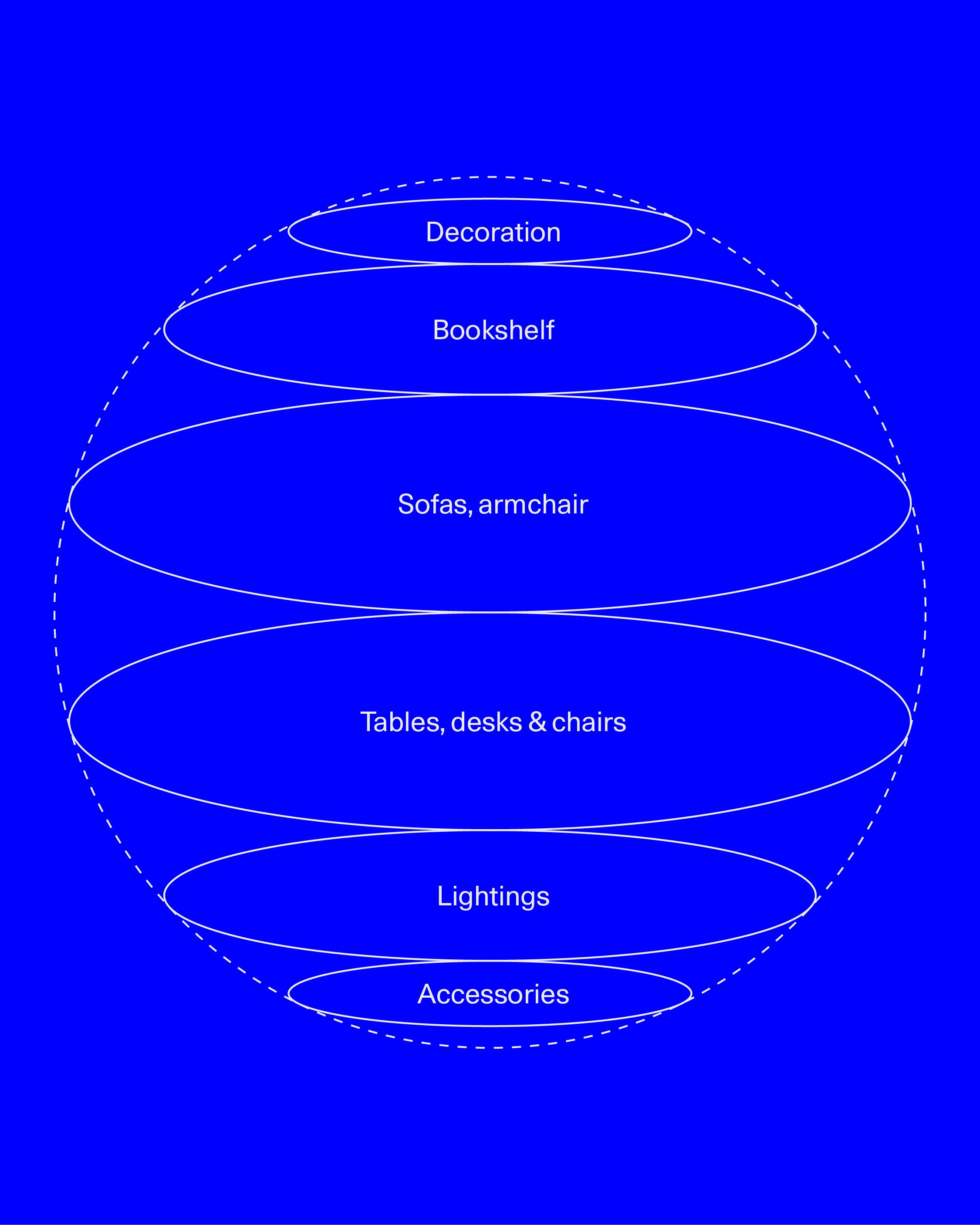
Domestic Ecosystem.
As the subject of endless reflections and discussions by theorists, philosophers, architects, and designers, the bookshelf remains, even today, one of those objects that, regardless of reading habits, must be present in every home. As Umberto Eco wrote, the bookshelf is not just the place where books are kept but also "a place that reads them for us. [...] a living organism with an autonomous life". Moving our eyes across the spines, flipping through the pages, that book becomes part of our daily environment. And even if its presence occasionally sparks a feeling of guilt for not having read it yet, it remains an integral piece of the personal library we have built, which continues to expand, sometimes against our will (fig. 2).
Despite the growing prevalence of digital text cataloging systems, the materiality of books seems to endure, carrying with it a continual reinterpretation of the bookshelf itself. In fact, as Shannon Mattern, researcher and professor of Media Studies at the University of Pennsylvania, points out:
“[I]n the digital age, these analog monuments take on new meaning; they might represent a wistful return to the tangible, or they might be an attempt to render empirical, affective, or phenomenological the taxonomies and algorithms that so palpably, if invisibly, structure our collections—and our everyday lives."
To navigate this vast universe, we will explore four different types of bookshelves and examine their behavior in captivity—specifically when interacting with other objects and entities within a room.
Before we begin, it's important to note that different bookshelf categories often overlap—wall-mounted bookcases, for example, can also be modular. However, it can be helpful to keep these models separate in our minds, at least ideally, to better understand their distinct origins and the unique needs they aim to fulfill, among other factors.
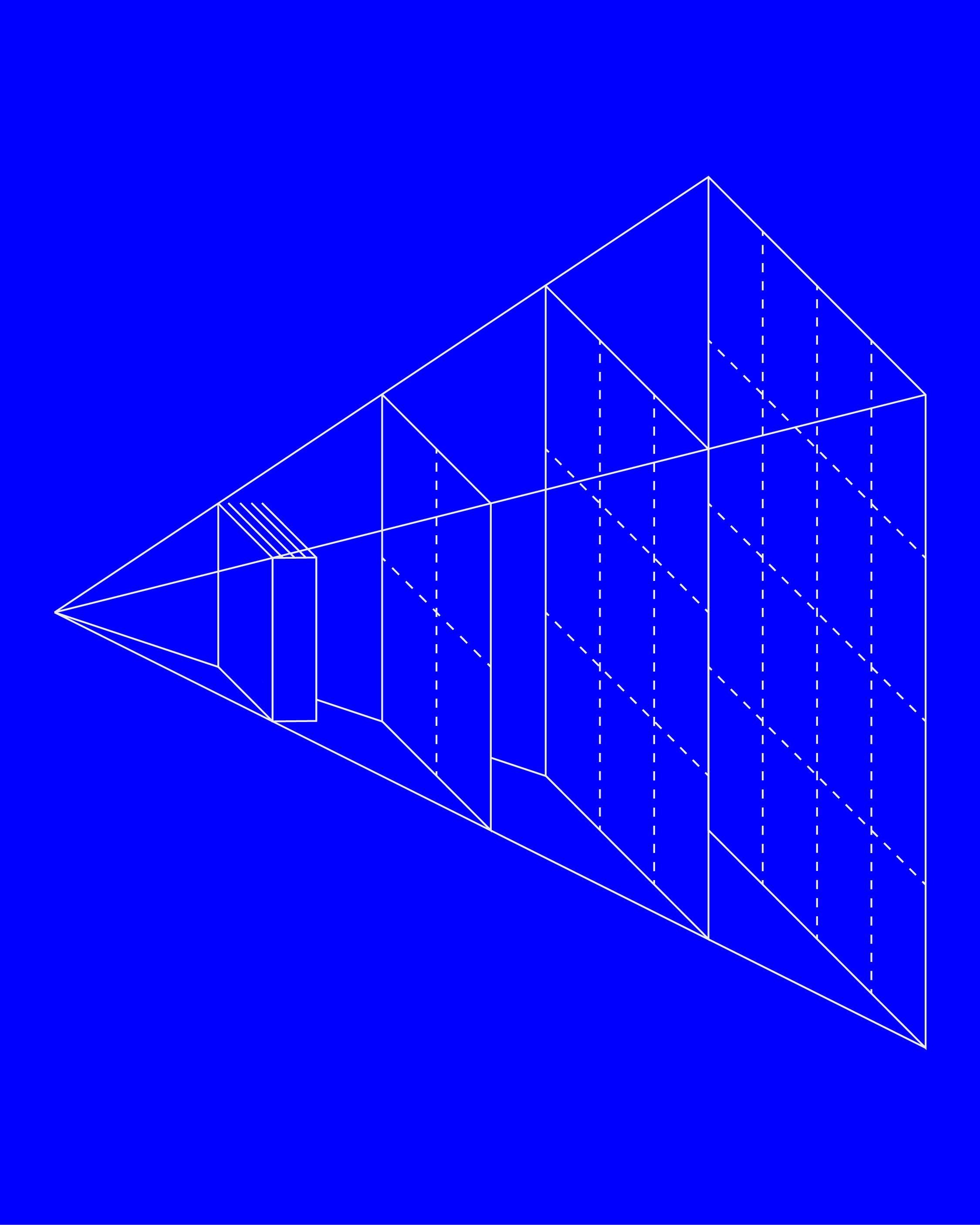
The living relationship between books and shelves.
Modular Bookshelf
Our first case study in this category focuses on modular bookshelves. Made from metal or wood, their main characteristic is their potential for expansion. Typically lightweight, they can adapt to any space, maintaining a discreet presence without overwhelming the environment. We’re on the same page if you're thinking of IKEA’s bestseller Billy. One of its key features is its elasticity coefficient. Its core can be defined as a single cube, and the bookshelf can shrink or expand indefinitely.
It’s no coincidence that the modular bookshelf is often associated with the DIY (Do It Yourself) philosophy. Long before IKEA made it mainstream, in 1974, Enzo Mari published his book “Proposta per un'autoprogettazione,” which contained instructions on how to build your own chairs, tables, and bookshelves. For Mari, the industrialization of products had severed the connection between people and the objects they spent most of their time with. People could approach these objects with a more critical eye by physically engaging in the construction of their own furniture. This DIY attitude echoes the very concept of modularity. In the design philosophy of Dieter Rams, lightness is translated into functionality. The 606 Metal Shelving System, designed in 1960, was conceived as a durable and minimalist bookshelf that could easily be modified without completely rethinking its framework, encapsulating the concept of elasticity.
Wall-Mounted Bookcases
Wall-mounted bookcases are the kind you think of when you imagine traditional libraries: sturdy, solid, and elegant. With its retro style, the wall-mounted bookshelf fulfills a need different from its modular counterpart. Drawing inspiration from noble or aristocratic homes, it evokes much more than a lightweight and humble modular bookshelf, a sort of personal library. It's the kind of image you'd want to have in the background during a Zoom call, so to speak.
To serve its purpose, it needs an entire wall—or at least a suitably sized space—to assert its presence. Unlike the modular bookshelf, the wall-mounted bookshelf’s personality tends to be firm and decisive (fig. 3). Because of its confident form, the displayed book must be carefully selected.
A great alternative to the wall-mounted bookcase is the Ready-Made Bookshelf, a project by NEXT architects featuring faux spines of classic books – the must-haves to show off in your home. The spines act like long vertical buttons that can be pushed in to insert your own books. No cultural FOMO: everything is already set up, so you can take your time to secretly read the books you actually buy without ruining the look of the shelf. Unlike the modular bookshelf, the composure of a wall-mounted shelf refers to a solid structure capable of withstanding changes - aesthetic and physical - to the home itself. If you don’t believe it, just ask anyone who’s had to move.
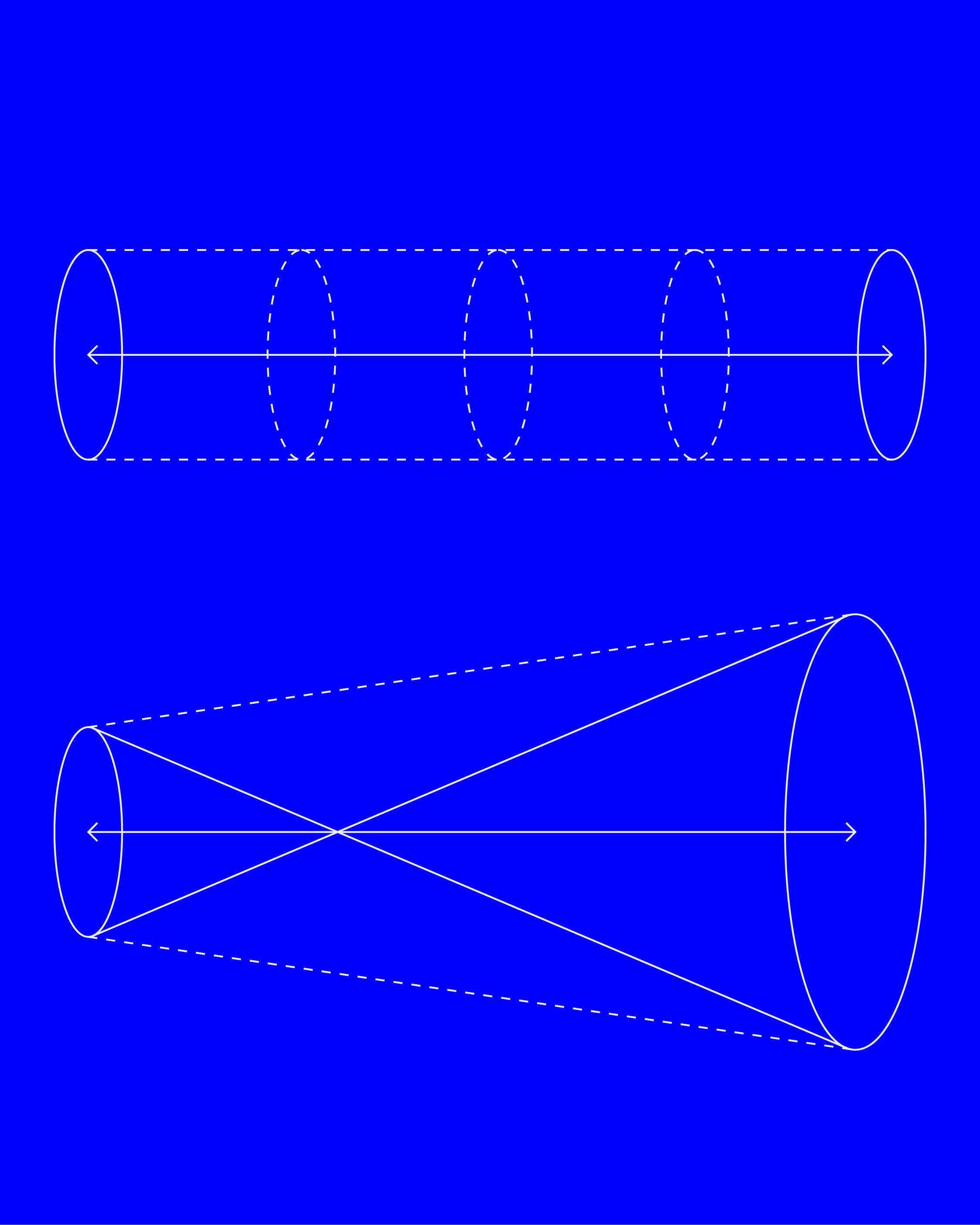
Unity vs Elasticity.
Freestanding Bookshelves
Often wider than they are tall, freestanding bookshelves blend easily with other furniture in a room. Typically Scandinavian in style and low in profile, these bookshelves are known for their understated character. Their shelves can hold books and objects of various kinds, creating an eclectic mix. These bookshelves are versatile: they can be integrated and assembled with other pieces of furniture, adapting to different configurations. However, their presence may be less pronounced compared to other types of bookshelves, and there’s a risk they could be mistaken for mere storage units for excess books. One of their distinctive features is their nomadic nature. By not being tied to a specific room, they can be moved even outside the home. Additionally, they can evolve and transform into other types of furniture. Their identity as bookcases is flexible, and they have an excellent fluidity coefficient that allows them to adapt to different needs and environments.
That doesn’t mean they can’t develop a sense of unity, a characteristic often associated with wall-mounted bookshelves. A prime example of this is the Carlton, the famous bookshelf designed by Ettore Sottsass as one of the first works of the Gruppo Memphis. Composed of colorful geometric forms, the Carlton takes shape through a series of elements that, while distinct, form a harmonious whole, almost anthropomorphic in appearance, resembling a totem. Loved by David Bowie, this bookshelf shows how books can conform to the shelf's lines. Yet, despite its apparent unity, the Carlton retains its nomadic character and strong fluidity: the drawers included in its structure confirm that, as a bookshelf, it can easily transform into a container for objects and photographs or simply remain in its bare, beautiful form.
Suspended Bookshelves
This term refers to bookshelves that follow the shape of the wall itself. These shelves don’t have a supporting structure, and they’re perfect to be placed near a staircase or, for example, above the sofa. Sure, one could call these structures just shelves, but the term might sound too limiting. They are, in fact, bookshelves, as they can stack into multiple levels, forming a bookshelf with an invisible structure. Those familiar with this method and adept at organizing the various texts they place on these shelves know suspended bookshelves create a unified collection, even when scattered across different areas of the house. Like different tentacles of the same book-body, books can be distributed across various house rooms: a staircase shelf for fiction books, a kitchen shelf for cookbooks, and so on. We'll discuss how to arrange your books in future episodes. Just as the DNA of a modular bookshelf was defined by a single cube, the minimal repeatable unit for suspended bookshelves is the individual shelf. In this sense, they are nomadic by nature.
Their essence as an internal framework means they can be easily disassembled and reassembled elsewhere. Another important characteristic of shelves is fluidity. In fact, with enough creativity, any type of shelf or material can serve as a book support.
This is the case with BOOKEN, a bookshelf designed by the British design studio Raw-Edges. Wooden cavities in the shape of rectangles are fitted with horizontal wooden rods that serve as book supports and bookmarks. Books are placed horizontally, with the page inserted at the desired point. When viewed from the front, this bookshelf shows the profiles of the books, with the spine visible only from above. This way, the spine of each book becomes a shelf itself, allowing for other items—or, why not, more books—to be placed on top. Much like the camouflage of cephalopods, suspended bookshelves can blend into their environment, sometimes even being perceived as simple shelves. Fluid by nature, they don't seek to be perceived as the one grand and solitary bookshelf in your home.
Unity, Elasticity, Sedentariness and Nomadism + Fluidity
By describing these four archetypes of bookshelves, several interesting characteristics have emerged that, ideally, form key points to consider when exploring their behavior. For instance, the concept of elasticity. On the other hand, we find the concept of unity. Bookshelves with a strong sense of unity are objects proud of their solidity: they are demanding because they require a tailored space. A space that allows them to display their almost sculptural form. In this sense, unity also refers to the fact that these objects cannot be disassembled without losing their identity. This aspect also brings us to a third characteristic: sedentariness. A sedentary bookshelf is closely tied, both aesthetically and functionally, to the place it inhabits. It fits so well with the surrounding objects that it's difficult to move it to another location without it suffering. When discussing suspended and freestanding bookshelves, another concept emerged that transforms this trio into a square model; the idea of nomadism, the mirror opposite of sedentariness. This aspect concerns bookshelf formats that can be moved and adapted to any environment without particular difficulty (fig. 4).
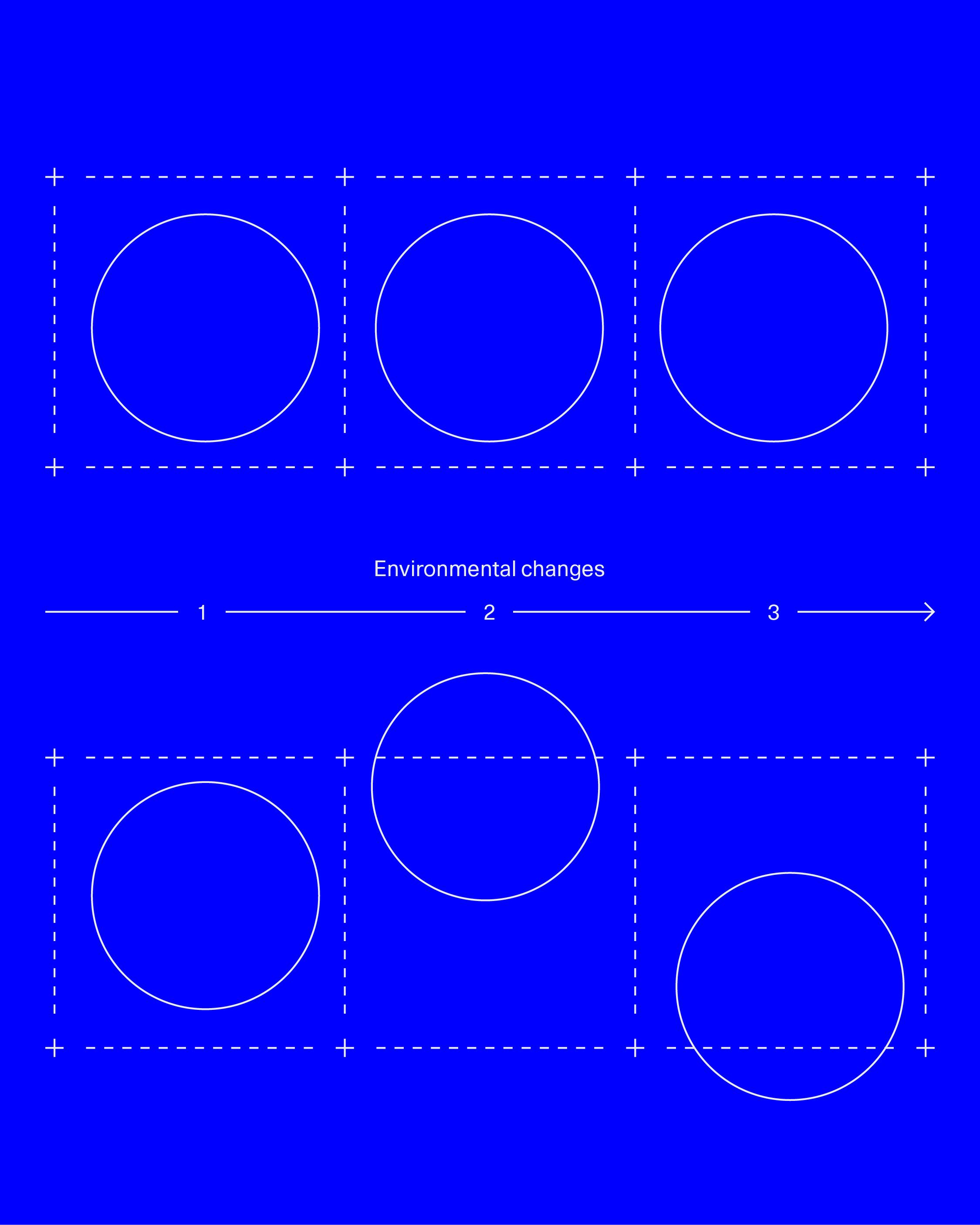
Sedentariness vs Nomadism.
While analyzing suspended and freestanding bookshelves, another value emerged: fluidity (fig. 5). With this term, as we saw, we mean the ability of a bookshelf to change its nature and transform its identity. From bookshelf to vinyl record holder, from photo frame holder to bookshelf again, and so on, following the infinite fluctuations of your life. In this sense, every bookshelf possesses its own gradient of fluidity, leading us to consider it a metavalue. It indicates an open field of possibilities that creates dynamism in the other values described.
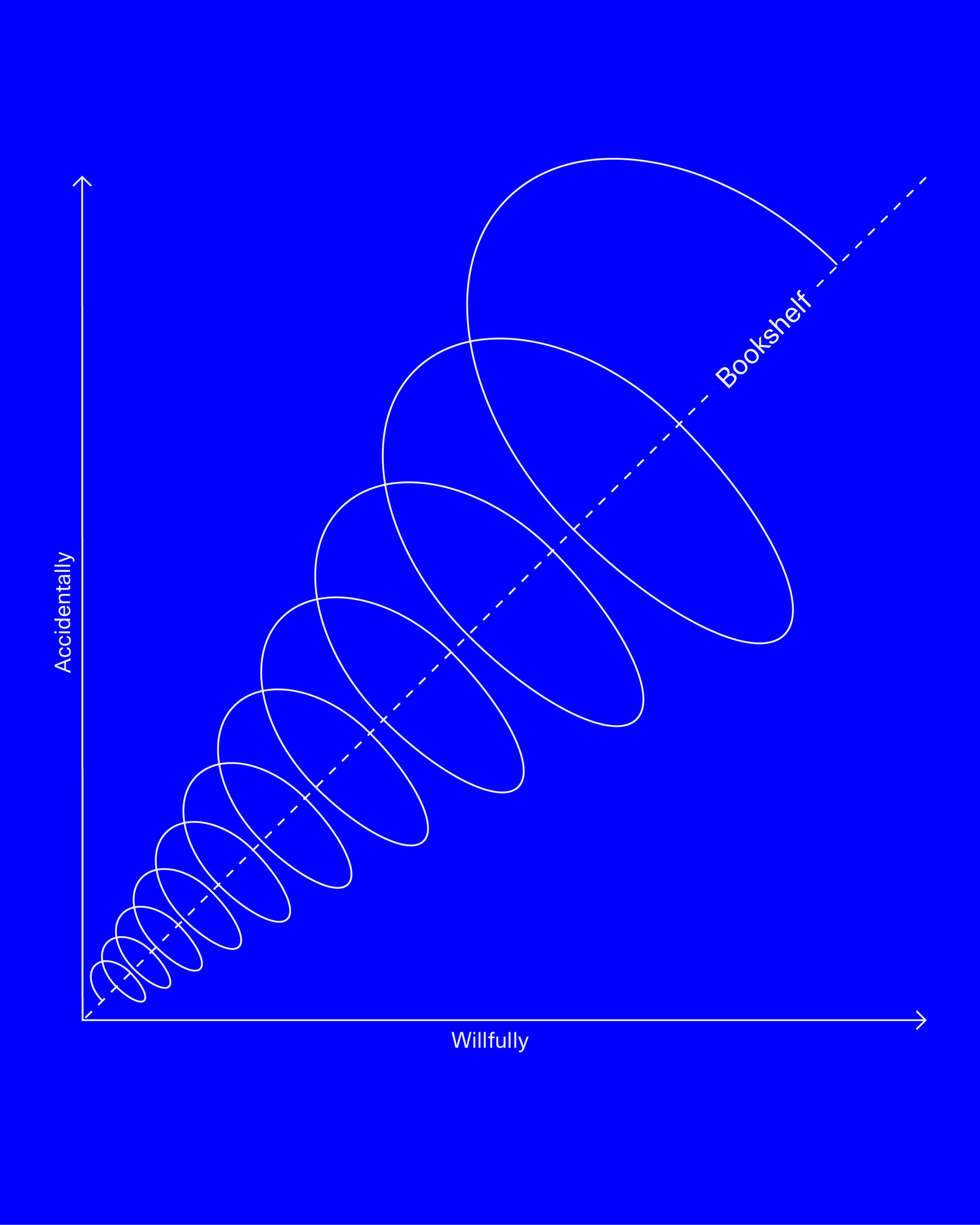
Fluidity.
Before concluding, let's clarify one key point. One might wonder if these archetypes truly align with their respective concepts. However, we've seen that these concepts can intermingle by examining specific examples of bookshelves. The Carlton bookshelf, for example, demonstrates the characteristics of a unified bookshelf, even though it belongs to the category of freestanding bookshelves. The fluidity also allows for different levels of nomadism, sedentariness, unity, and elasticity, positioning itself as a transversal value (fig. 6).
We hope the insights gained from our study of the ethology of bookshelves will help guide your future choices. On the side you can find a compass with some of the bookshelves that have been mentioned that you can download or print to help you apply these criteria.
Enjoy 🐻
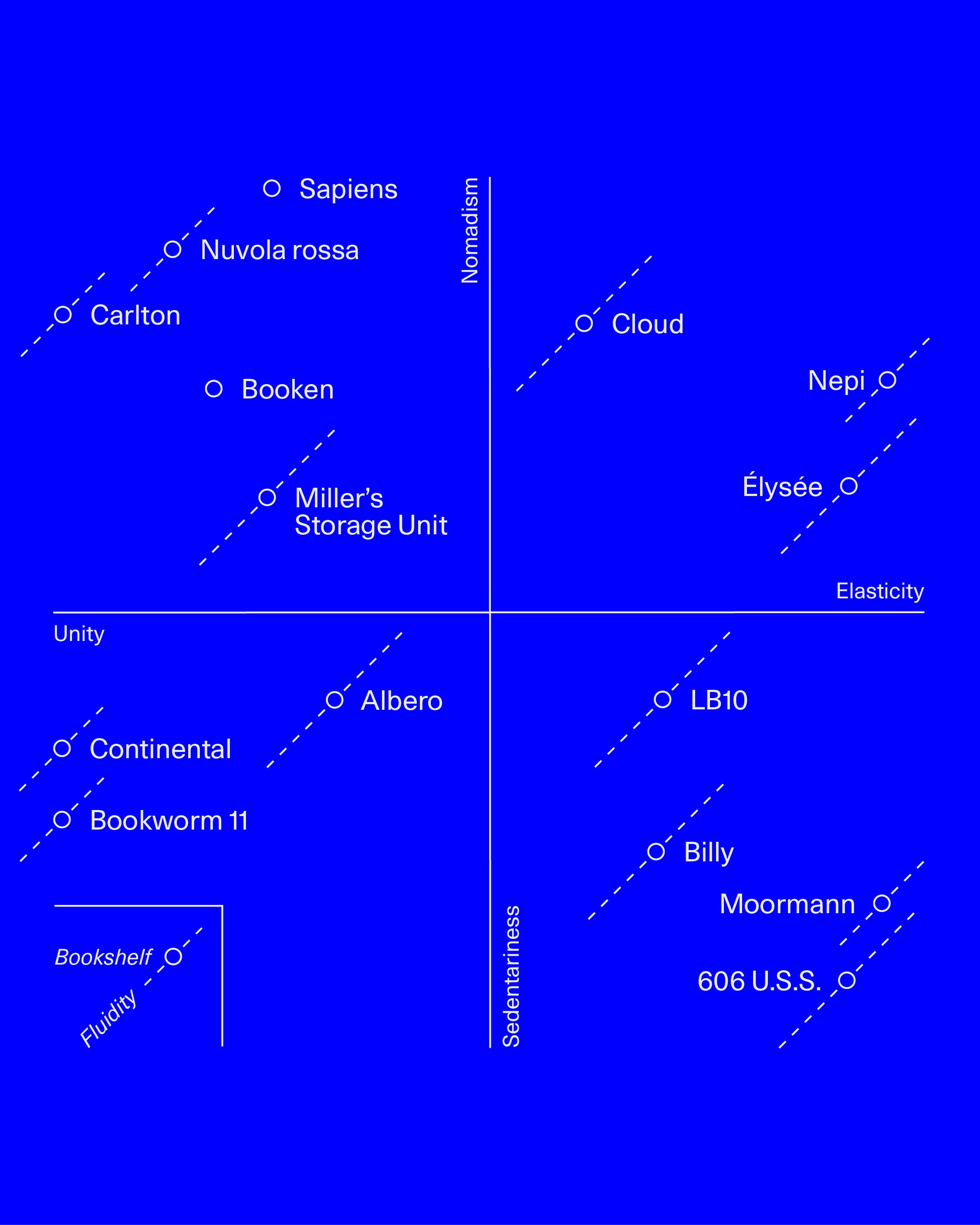
B.C. (Bookshelves Compass).